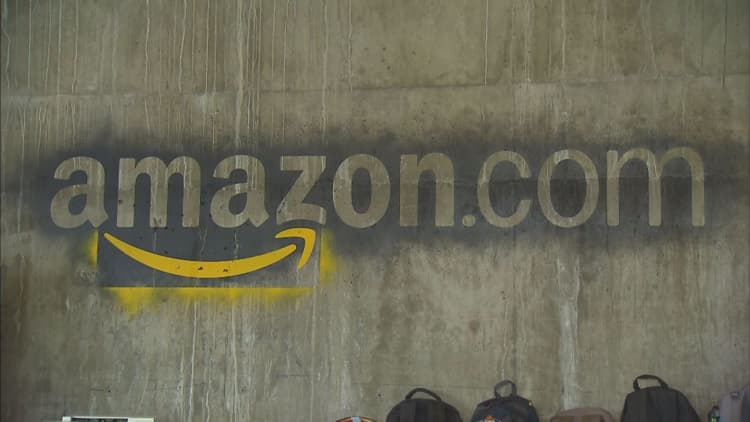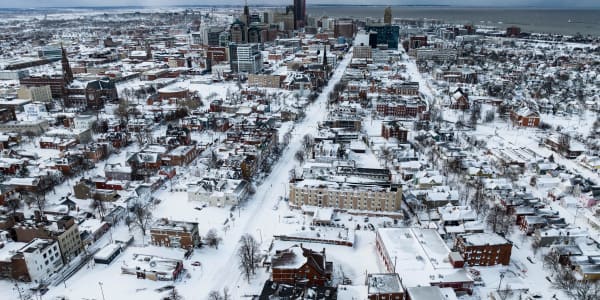Of the 20 finalists for Amazon’s coveted HQ2 project, only seven made CNBC's Top 10 list in this year’s America’s Top States for Business study. They are Atlanta; Dallas and Austin, Texas; Boston; Denver; Northern Virginia; and Raleigh, North Carolina.
But CNBC's Top States study offers clues on just about all the finalists. If Amazon wants a great workforce, it might look to Boston, based on our Top States ranking of Massachusetts as No.1 in the category. If infrastructure is at the top of the list, Austin or Dallas are in the state with the best infrastructure—Texas. If Amazon values low costs, the company might look to Indianapolis, capital of its state and offering the nation's fifth lowest cost of doing business. Or perhaps, New York, which is the most generous with incentives.
Amazon has promised a decision this year on where it will locate the $5 billion project, which it says will eventually employ 50,000 people. After initially receiving bids from 238 locations in North America, the company pared the list to 20 finalists in January. It has said little publicly since.
In its initial request for proposals last year, the company laid out four main criteria for the new location:
· Metropolitan areas with more than 1 million people
· A stable and business-friendly environment
· Urban or suburban locations with the potential to attract and retain strong technical talent
· Communities that think big and creatively when considering locations and real estate options
Those criteria differ from our Top States study, which covers 10 categories of competitiveness, weighted based on how frequently the states use them as selling points. But within our data—and the 64 metrics we use—are some potential clues about which locations have the edge.
Of course, two of the finalists—Washington, DC and Toronto—are not in states, so this is no help to them. But here is what the data says about the other 18:
Atlanta
Georgia is a perennial Top States favorite, finishing No. 7 this year. It was America’s Top State for Business in 2014. This year it can make a strong case for almost everything Amazon is looking for. The economy is stable — the second best in the country, according to our study. State GDP grew by a solid 2.7 percent last year, and Georgia has added more than 76,000 jobs over the past 12 months. Georgia’s workforce is among the best in the nation, with little union presence and a larger-than-average concentration of science, technology, engineering and math (STEM) employees.
However, it is in the bottom half for educational attainment — just 29 percent of adults have a bachelor’s degree or higher. Georgia’s legal and regulatory climate can be tough, with the U.S. Chamber Institute for Legal Reform giving it poor marks for its handling of tort cases. That is one reason the state finishes No. 21 for business friendliness. And it can be stingy with tax breaks and corporate incentives, finishing in the bottom 10.
Austin, Texas
Being located in America’s Top State for Business can’t hurt Austin’s chances, but the city is not a lock, either. The Texas economy is on fire these days, ranking No. 1 in our study. Stability is a bit of an open question, however. Texas finished No. 25 in the category last year. As much as the state has done to diversify, there is no getting around the state’s dependence on oil. In addition, state fiscal planners are warning about a budget crunch next year.
The Texas workforce is outstanding. Statewide, 29 percent of adults have bachelor’s degrees, but the number is almost certainly higher in the home of the University of Texas. Workers are in short supply, however, with unemployment in May at 2.8 percent. The state loses points in business friendliness because of its tough legal climate, and a lack of protections against discrimination hurts its quality of life.
Boston
Massachusetts vaults into the top 10, finishing No. 8 this year largely on the strength of the best workforce in the country. It also finishes No. 1 for Education, with strength at all levels — from the top 4th- and 8th-grade test scores in the nation, to top colleges and universities, including Harvard, MIT and the University of Massachusetts. If that is what Amazon means by “the ability to attract and retain top technical talent,” then this state clearly has a shot.
Where Massachusetts falls short, however, is in its infrastructure — a factor Amazon discusses in its request for proposals, particularly involving mass transit. Based on what Bostonians endure in getting to their jobs every day, Massachusetts has some work to do. According to the Census Bureau, the average commute to work in the state is the fifth longest in the nation at just shy of 30 minutes. It is even longer in metropolitan Boston, where Amazon is thinking of locating.
Massachusetts is also expensive, with the third-highest cost of living in the nation, including high real estate costs. However, it is unclear where cost fits into Amazon’s equation.
Chicago
By our measures, Illinois is not a stable, business-friendly environment, which is one reason the state ties with Maryland for No. 28 this year. State finances are a mess — both Moody’s and Standard and Poor’s rate its debt just one notch above junk — pushing the state to No. 42 in Economy. It finishes No. 47 for Business Friendliness.
But don’t count Chicago out just yet. Illinois is a cradle of innovation, thanks to a strong talent base as well as top-notch colleges in the Chicago area, like the University of Chicago and Northwestern. Its workforce ranks a paltry No. 25 (tied with Ohio), but that has a lot to do with the state’s heavy union presence and the fact college-educated adults are not gravitating to the state.
The educational attainment among the workforce is a positive, however. About 33 percent of adults hold at least a bachelor’s degree.
Columbus, Ohio
Ohio clearly has shed its Rust Belt past with a robust presence in industries like health care, information technology and aerospace. The state finishes at a respectable No. 15 in our rankings this year. inside the data are some factors that make a more compelling case for Columbus. Ohio only ranks No. 25 for Workforce (tied with Illinois), but that takes the entire state into account rather than just Columbus — a dynamic university town if ever there was one.
The state is a leader in worker training programs, and it has a strong concentration of technical talent. However, the state ranks in the bottom tier for Business Friendliness, at No. 37, because of its regulatory climate. And while it scores a solid No. 4 for Infrastructure, air travel options are limited.
Dallas
The second of the two finalist cities located in America’s Top State for Business, Dallas particularly benefits from Texas’ top-rated infrastructure. Dallas–Fort Worth International Airport, which offers flights to 229 destinations, boasts that passengers can reach any major U.S. city in four hours. Like Austin, Dallas is home to a strong, tech-oriented workforce, but supplies are tight with 3.4 percent unemployment.
Among the other issues hurting Texas’ quality of life are rising crime rates and the fact the state has the largest percentage of people without health insurance — a surprising 19 percent, according to the Census Bureau.
Denver
Of all the finalist cities, Denver arguably has the most in common with Seattle — an environment Amazon has said it hopes to replicate in its second headquarters. The two cities have almost identical populations — around 600,000, with almost the exact same percentage of millennials. And those populations love the outdoors and the arts.
Colorado, which ranks No. 5 this year, also shares many of the same strengths and weaknesses as Washington. On the positive side, it has a strong, educated workforce — ranking No. 5 in the category, including the nation’s fourth-largest concentration of science, technology, engineering and math (STEM) employees. The economy is solid, growing by 3.2 percent last year, though Colorado is dealing with large state pension obligations. Quality of life is good — the population is healthy, and Colorado prides itself on inclusiveness.
One issue: Just like Washington, Colorado is plagued with poor infrastructure and high costs.
Indianapolis
No. 16 Indiana has the stable, business-friendly environment going for it. State finances are solid, though the housing market is a bit sluggish compared to some parts of the country. And the state prides itself on a pro-business regulatory climate.
No state has better roads, and commutes are a breeze, averaging just under 24 minutes. Air travel options could be better, however. But where the state really falls short is its No. 40 Workforce ranking. Only about 24 percent of adults have a bachelor’s degree or higher. Underfunded public schools do not help.
Los Angeles
By our measures, California ranks smack dab in the middle of the states at No. 25. But the state — and Los Angeles, in particular — have many of the things Amazon wants the most. The state’s workforce may be rated No. 12 in our study, but it is among the nation’s most educated. It is also the second most productive (behind Alaska), with the average nonfarm California worker accounting for about $138,000 in economic output, according to government statistics.
And California has one of the nation’s highest concentrations of STEM workers. Despite all of the talk about people fleeing California’s high costs, the state is still among the best at attracting educated adults. Nearly 300,000 adults with a bachelor’s degree or higher moved into the state in 2016, according to the Census Bureau.
Miami
No. 10 Florida gets high marks for its infrastructure, with a plethora of air travel options. Its economy is strong, with 2.2 percent GDP growth last year and a strong state balance sheet. And the state always does well for Business Friendliness with its comparatively small, transparent government. Florida’s workforce gets a mediocre grade, however, finishing No. 27. Only about 28 percent of adults have bachelor’s degrees or higher.
Where the state shines, however, is in attracting educated workers. Whether they moved there for the booming economy and job market, the low taxes or something else, more than 200,000 adults with a bachelor’s degree or higher moved to the state in 2016. On a percentage basis, that is the highest in the nation.
Montgomery County, Maryland
Maryland is another state where the overall ranking — No. 31 — does not necessarily tell the whole story. If Amazon is most interested in locating in a state with a great workforce, Maryland — and particularly the D.C. suburbs in Montgomery County — is hard to beat.
Maryland finishes No. 6 in the Workforce category. Maryland workers are among the most educated, and the state boasts America’s largest concentration of STEM workers. More than 9 percent of its workers are in those key occupations, according to the Census Bureau. The state falters, however, on infrastructure, with the second-longest commutes in the country, at nearly 33 minutes on average, and roads badly in need of attention.
Nashville, Tennessee
Tennessee has been quietly writing a compelling economic story, finishing at No. 14 this year, compared to No. 9 last year. The state’s economy ranks No. 7 this year, thanks to solid GDP growth — up 2.5 percent last year — and steady job growth, up 1.8 percent in the past year.
But Tennessee’s workforce falls short in important measures, like educational attainment. Only about 29 percent of its population have bachelor’s degrees or higher — and the concentration of STEM workers is lacking. Only about 4.7 percent of the workforce is in science and technology occupations.
Newark, New Jersey
New Jersey raised plenty of eyebrows when it offered Amazon $7 billion in incentives to set up shop in the state. But the state will also have to deliver the goods on Amazon’s stated criteria. Stability and business friendliness have not been hallmarks of the Garden State, which has among the worst state finances in the nation, with some $45 billion in unfunded pension obligations.
But New Jersey’s workforce — which ranks a tepid No. 18 — nonetheless has some features Amazon might like. More than 43 percent of the workforce holds a college degree, putting New Jersey workers second in the nation for educational attainment. The state has the seventh best education system in the country, based on our study.
New York City
New York State is the most improved state in this year’s rankings, moving up 11 spots to No. 27 overall. But that does not tell the full story of the dynamism in America’s largest city. Remember how New Jersey workers were the second most educated in the nation? The most educated are in New York, where 44 percent hold at least a bachelor’s degree. New York’s education system is among the best in the country. The state is big and diverse, so our overall ranking captures the good and bad across a very large area.
But New York City has a robust tech scene with a wealth of start-ups in the section of Manhattan known as Silicon Alley, as well as established companies setting up standalone tech operations. United Technologies, for example, is hiring some 250 people for its Digital Accelerator project in Brooklyn. No wonder the state earns a No. 4 ranking in Technology and Innovation.
The state’s infrastructure ranks poorly due to long commutes and aging utilities, but within that category, few states beat New York when it comes to air travel options. New York is notoriously expensive with high wage costs, pricey real estate and the nation’s fourth highest cost of living. But the state makes up for some of that by being the most generous in the nation when it comes to corporate incentives and tax breaks. If that counts for the “creative thinking” Amazon says it is looking for, New York could have a shot.
Northern Virginia
Stable? Check. No. 4 Virginia, almost always a contender in our rankings, enjoys a solid AAA credit rating from the major agencies and a good — but not perfect — economy. Business friendly? Check. Already placing a solid No. 5 for Business Friendliness, Virginia recently passed a bipartisan reform bill aimed at cutting state regulations by 25 percent in the next three years.
Virginia’s Workforce comes in third. It is among the most educated and tech-savvy, with 8.7 percent working in STEM professions. But the state can be costly, finishing No. 33 for Cost of Living and No. 34 for Cost of Doing Business.
Philadelphia
At No. 22, Pennsylvania is not a standout in our overall rankings. But its education system — ranked No. 7 — is strong, led by a vast array of post-secondary institutions, including the University of Pennsylvania, Drexel and Temple. Once educated, Pennsylvania students tend to stay put, giving the state one of the best-educated workforces in the nation. Around 38 percent of adults have at least a bachelor’s degree.
Philadelphia is conveniently located, with easy access to New York, Washington, D.C. and the rest of the Northeast Corridor. But the infrastructure — including one of the largest percentages of structurally deficient bridges in the nation — could use some work.
Pittsburgh
For two big cities on either side of a state, the rivalry between Pittsburgh and Philadelphia is not terribly fierce. But it is fair to assume that if one of the two cities wins HQ2, the other will not live it down. Pittsburgh enjoys the same workforce advantages as Philadelphia.
But one area where the state lags is its No. 41 Economy. State GDP grew by 1.8 percent last year, though it has picked up the pace a bit to start this year. Job growth at just 1.3 percent year-over-year statewide is on the slow side. Adding to Pittsburgh’s challenges: its declining population, down 1.3 percent in the last five years, according to the Census Bureau.
Raleigh, North Carolina
North Carolina performs well in our rankings year after year — finishing ninth this year — because of many of the things Amazon seems to value the most. The state has a smart, tech-savvy workforce, cultivated in the renowned Research Triangle region that includes Raleigh.
North Carolina’s sixth-ranked economy is showing steady growth — GDP up 2.3 percent last year. State finances are stable, and the housing market is also good.
But a particularly weak spot — and one that could come into play in the HQ2 sweepstakes — is education. The state finishes No. 37 in the category this year, as school funding lags the nation, and high school test scores appear to show the result. The average composite score on the ACT last year, 19.1, is the fifth worst in the nation.
WATCH: What Amazon is asking cities for its HQ2








